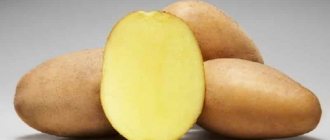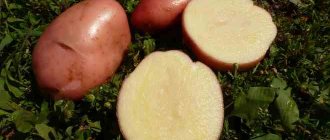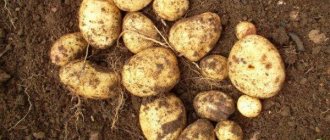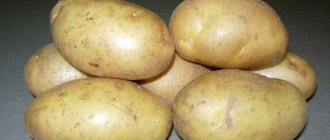Features of planting and growing
When cultivating this vegetable, it is recommended to take into account some nuances. The culture is demanding to care for and requires patience and certain skills.
Preparing for landing
Tubers begin to be prepared 1.5 months before planting. They are transferred from storage to a warmer place and laid out in one layer.
When the sprouts reach 2 cm, the potatoes are brought out into the light so that the sprouts do not stretch too much.
Soil requirements
The yield and taste of vegetables depend on the composition of the soil. The most unsuitable soil for purple potatoes is loam, the most favorable is light and fertile, saturated with air. The vegetable does not tolerate drought well, but stagnation of water must also be avoided.
Before planting, the soil is dug up twice: in the fall, before the first frost, and in the spring, immediately before planting. If the soil is too hard, add river sand.
Dates, scheme and rules of planting
The vegetable is planted in the spring, when the soil warms up to +5...+7°C, since the plant does not tolerate late spring frosts.
Holes about 10 cm deep are made in the dug up soil, and wood ash is added for disinfection. The holes are made according to a 35x60 cm pattern to provide enough space for rooting and formation of bushes. Potatoes are planted in the prepared holes using one of the selected methods.
Features of cultivation
Growing purple potatoes is no different from cultivating regular varieties.
There are two planting methods:
- traditional eyed;
- seedling
With the eye method, the prepared seed material is buried in the holes, sprinkled with wood ash. The first shoots usually appear 10–14 days after planting.
In the second option, the seeds are sown at home for seedlings. After this, the finished sprouts are transferred to a permanent place. Replanting begins in May, when the soil warms up to +5...+7°C.
Nuances of care
To successfully cultivate purple potatoes and obtain a rich harvest, you need to feed the plants, water and weed in a timely manner.
Watering mode
Caring for plants involves constant monitoring of soil moisture. If there has been no precipitation for 10–15 days, the seedlings are watered with warm water
Irrigation is especially important during budding and after flowering. It is necessary to avoid stagnation of water in the soil
When an earthen crust forms, it is thoroughly loosened.
Top dressing
Purple potato varieties require periodic feeding: during budding and after flowering. Organic and potassium fertilizers are used. Before planting, it is advisable to add humus at the rate of 0.5 kg per 1 m2.
Weeding and hilling
The first hilling is carried out after the appearance of friendly shoots. This will protect young bushes from return frosts and retain moisture. The procedure is repeated when the plants reach a height of 30–35 cm.
Weeding is carried out several times during the summer as needed.
Disease and pest control
Many varieties are resistant to major potato diseases, but precautions are never superfluous
It is important to change the planting location, alternating crops on the site with legumes and cruciferous vegetables. For potato diseases, use Bordeaux mixture, copper sulfate, Kuprikol, Kurzat R (preparations based on copper salts), Ditan M-45 (active ingredient - mancozeb), Shirlan, Thanos
For potato diseases, Bordeaux mixture, copper sulfate, Kuprikol, Kurzat R (preparations based on copper salts), Ditan M-45 (active ingredient - mancozeb), Shirlan, Thanos are used.
Colorado beetles and click beetles are the main enemies of the crop. They spoil the tops and appearance of tubers, reduce productivity and negatively affect the shelf life of vegetables. Pests are eliminated using insecticides.
Landing dates and rules
Potato yield depends on the planting date. Agronomists warn amateur gardeners against planting too early; there is also no point in delaying it. Typically this period occurs at the end of April - beginning of May. The earth should be warmed up to eight to ten degrees, at this temperature the tubers begin to grow. There is no point in planting them in cold soil; they will simply lie there uselessly.
Article on the topic: Potato variety “Colomba” - description and photo
Potato planting material should be the size of a chicken egg or slightly smaller. Tubers must be germinated before planting. This will make it possible to discard unsuitable planting material: tubers with thin thread-like shoots, as well as those on which small nodules have formed.
The rules for planting colored Blue Danube potatoes are the same as for light ones. Before planting, it is advisable to soak the potatoes in a solution of boric acid to protect the plants from fungal diseases that pose a danger to this particular variety.
When planting potatoes in order to obtain seed material, the distance between bushes in a row should be 20 cm. Commercial potatoes should be planted every 30 cm, the distance between rows should be 70 cm.
Colored potatoes need watering. “Blue Danube” under normal weather conditions should be watered at least three times; if the summer turns out to be dry, the number of waterings should be doubled. The main condition is that watering is not excessive, as this negatively affects the safety of the tubers. Potatoes need to be hilled and weeds destroyed in time.
Landing
You can plant it when the soil temperature reaches +12 and the frosts end. The potatoes are pre-prepared: sorted, unspoiled tubers (70-80 g) are selected, laid out in a well-lit place in a thin layer and allowed to germinate for several weeks. Maintain temperature +12-15 degrees. By the time of planting, the sprouts should be 2-3 cm long.
If every year you select tubers from the previous harvest for planting, after 5-6 years the variety will degenerate, the yield will fall, and the bushes will begin to get sick. Periodically, you need to update the variety by purchasing super-elite material from manufacturers or growing it from seeds.
The bed is chosen in a sunny place, preferably on light sandy loam or chernozem soils. It is prepared like this:
- Heavy, dense clay soil is loosened by adding sand and peat.
- Acidic (with a pH of more than 5.5-6) is deoxidized with dolomite flour, chalk or slaked lime.
- In the fall, dig up the soil and fertilize it with humus or compost (up to 5 kg per 1 sq. m in non-depleted areas and up to 10 kg in depleted areas).
- In the spring they dig up with mineral fertilizers.
Leave 20-30 cm between bushes, 50-70 cm between rows. The depth of the holes is 10-12 cm. A little nitrophoska or ash is poured onto the bottom.
Blue Danube potatoes: snow-white flesh under a lilac skin
Most gardeners in different countries know the Blue Danube potato as a vegetable crop from the field of organic farming. Despite the fact that during the cooking process the peel of the tubers of this variety remains bright purple, the potato flesh is snow-white.
Description of the variety
The Blue Danube potato variety, or Blue Danube, is a medium-early ripening vegetable crop.
When creating this variety, a potato called “Sarpo Mira”, well known for its high resistance to most diseases, was used. The bushes are very powerful, medium-sized, leafy.
The tubers are oval-oblong in shape, large, with a dense dark blue skin and white pulp.
Blue Danube potatoes are high-yielding varieties. Individual tubers reach a mass of 250 g or more. At least 8 tubers are formed in each bush.
Benefits of growing Blue Danube potatoes
The main advantages of growing such unusual potatoes for Russian latitudes are as follows:
- this grade is resistant to mechanical damage and cracking;
- one of the leaders in taste;
- high and stable productivity is noted;
- if stored properly, it does not spoil for a long time and does not sprout;
- presence of great germ potential;
- can grow and bear fruit well in depleted soils;
- resistant to most of the most harmful microorganisms and is practically not affected by black leg, tuberous scab, black scab, potato Y-virus, fusarium, leaf curl virus, nematodes and potato anthracnose. The variety can be cultivated without the use of chemicals that protect against diseases and pests.
Landing Features
Blue Danube is part of the Sarpo series. As a rule, all potato varieties included in this series do not require processing; thanks to their long hibernation, the tubers are perfectly preserved under normal conditions and do not require special refrigeration units.
The growing conditions for this potato variety are as follows:
The area for planting potato tubers should be fertile, sunny, without stagnant moisture. It is recommended to place planting rows in the direction from north to south, which will provide adequate lighting for all plants. About two weeks before planting in open ground, the planting material is placed in a warm place. It is necessary to carry out a pre-planting visual inspection of the seed material, since only healthy potato tubers with varietal characteristics are selected for planting. Potato tubers should be planted in soil heated to at least 8°C. Caring for potatoes after planting involves watering, hilling, and fertilizing. It is advisable to water potato plantings in the evening, which will allow the moisture on the foliage to dry out before the morning.
It is very important to completely stop watering about a month before the mass harvest, since excess moisture negatively affects the shelf life of the resulting crop.
A technique that is very effective is breaking the potato stem at a height of 15–20 cm from the ground, which inhibits the growth and development of the tops after flowering and promotes the redistribution of nutrients to the potato tubers.
Most even novice and inexperienced gardeners know that once every three or four years, the variety of potatoes grown in their garden plots needs to be updated.
In this case, experts recommend planting elite planting material.
The description of the Blue Danube variety and positive reviews from gardeners make it very popular today in home gardens.
Many potato growers note the absolute unpretentiousness of the Blue Danube variety.
Such potatoes are optimally suited for cultivation in our country and are adapted to unfavorable factors. Tubers, even in the absence of advanced agricultural technology, are formed very large.
On unfatigued soils, gardeners often observe excessively active flowering of potato bushes followed by the formation of seed material.
The potatoes are tasty and have proven themselves well after heat treatment. The pulp is very aromatic and does not overcook, which makes it possible to use it for making salads. When standard conditions are created, such potatoes are stored without loss of presentation and taste all winter.
Description and characteristics of the variety
The Blue Danube or Blue Danube variety from “Super Elite” is mid-early - the full ripening period is 65-80 days. The bushes are straight, powerful, and do not tend to lie on the ground. Medium in height. They bloom with purple flowers with a yellow center. One bush produces 8-12 potatoes with the following characteristics:
- oblong-oval shape;
- dark purple or blue-violet smooth skin with small eyes of medium depth;
- white flesh;
- average weight from 100 to 200 g; with abundant watering and fertilizing, specimens of 250 g or more grow;
- the pulp contains a small amount of starch - 13-16%;
- When boiled, the potatoes remain firm, do not fall apart, and are also suitable for any type of frying;
- commercial harvest yield from the total number of fruits is 84-96%;
- keeping quality is excellent, reaches 95%;
- excellent taste.
History of origin of the variety
Blue Danube potatoes were developed in Scotland in the early 2000s. In foreign catalogs it is called Blue Danube. The Sarpo Mira variety was taken as the basis. From him the new product received resistance to major diseases.
In 2005, the cultivar was included in the State Register of the Russian Federation. It is grown almost throughout the country and in neighboring states.
Diseases and pests
The variety is resistant to nematode (although it can be affected by some varieties), anthracnose, black leg, dry rot, leaf curl, and various types of scab. Resistance to late blight has not been reported. Fungal and viral diseases can affect potatoes if agricultural practices are not followed. For protection you need:
- Follow the rules of crop rotation. You cannot plant the crop in the same area for two or more years in a row, or place it after other nightshades (tomatoes, peppers, eggplants) or next to them.
- Monitor humidity. If potatoes are grown in a rainy region, mulch the soil and change the mulch frequently.
- Treat the soil with solutions of copper-containing fungicides before planting, seed tubers and plantings after germination.
- Fight against parasites that carry diseases.
The most dangerous pest is the Colorado potato beetle. If you do not fight it, you can lose half or more of the harvest (if more than 80% of the tops are damaged by the beetle, the yield drops by half). For control, insecticides “Confidor”, “Tabu”, “Regent”, “Aktara” and others are used.
In order not to use pesticides, beetles are collected by hand or poultry - chickens, partridges, pheasants, guinea fowl - are released into the garden. For prevention you need:
- plant peas or beans next to potatoes, the secretions of which repel pests;
- alternate rows of potatoes with rows of strong-smelling crops - onions, catnip, mint, calendula, marigolds;
- frequently hill up plants;
- When planting, place onion peels in the holes.
Diseases and pests
The variety is resistant to many nightshade diseases: potato canker, golden cyst nematode, common scab, various viruses: fusarium, alternaria, verticillium.
In unfavorable conditions, tubers or leaves may be affected by late blight. To prevent late blight, plantings are generously sprayed with copper-containing preparations. Mulching the soil with mown grass will protect the bushes from root rot or blackleg.
Like other dark-fruited varieties, Smuglyanka attracts insect pests. Plantings are threatened by Colorado potato beetles, wireworms, and mole crickets. Periodic spraying with insecticides and pre-treatment of the soil and tubers before planting help.
Chemical preparations will help in the fight against the Colorado potato beetle: Aktara, Corado, Regent, Commander, Prestige, Lightning, Tanrek, Apache, Taboo.
Potato “Smuglyanka” is a young but very promising variety, rightfully considered the star of Ukrainian selection. It is ahead of its competitors in terms of yield, taste, resistance to diseases, and commercial qualities of tubers. Potatoes can be planted in industrial fields or in personal gardens; they are absolutely universal.
There are many ways to grow potatoes - from standard to the most exotic. We bring to your attention articles about Dutch technologies, about how to grow potatoes from seeds, under straw, in bags and barrels, in boxes or boxes without a bottom.
We also bring to your attention other potato varieties with different ripening periods:
| Late ripening | Mid-early | Mid-late |
| Picasso | Black Prince | Blue |
| Ivan da Marya | Nevsky | Lorch |
| Rocco | Dark-skinned girl | Rowanushka |
| Slav | Lord of the Expanses | Nevsky |
| Kiwi | Ramos | Courage |
| Cardinal | Taisiya | Beauty |
| Asterix | Lapot | Milady |
Benefits of growing Blue Danube potatoes
The main advantages of growing such unusual potatoes for Russian latitudes are as follows:
- this grade is resistant to mechanical damage and cracking;
- one of the leaders in taste;
- high and stable productivity is noted;
- if stored properly, it does not spoil for a long time and does not sprout;
- presence of great germ potential;
- can grow and bear fruit well in depleted soils;
- resistant to most of the most harmful microorganisms and is practically not affected by black leg, tuberous scab, black scab, potato Y-virus, fusarium, leaf curl virus, nematodes and potato anthracnose. The variety can be cultivated without the use of chemicals that protect against diseases and pests.
Main features of the variety
Potatoes with purple tubers are a wild crop from South America. In the European part, there was no planting of this species for a long time. Modern scientists have carried out work on the selection of American game and familiar potato varieties.
Please note! No genetic modification methods were used in the production of new purple varieties. Exclusively classical selection options were used.
General distinctive features of potatoes with unusual colors:
- oblong clunies;
- useful components included in the composition help improve immunity;
- good preservation rates due to the dense peel;
- The purple tint of the pulp remains even after cooking.
The culture is distinguished by its characteristic nutty taste after processing.
History of appearance
The purple tuber crop first appeared in North America in the Andes Mountains as a wild crop. Thanks to the work of breeders, this variety is grown in Europe.
People made the first attempts to grow purple root vegetables in Siberia. The result was achieved only in 2011 in Tomsk. The seed material used was brought from Korea.
Many varieties of purple potatoes have been developed. They differ from each other in the intensity of color.
Characteristics of tubers
Purple root vegetables are distinguished because of their special taste. Many of the varieties have a nutty flavor, especially when cooked. This circumstance gives the dishes piquancy and unusualness.
The tubers of the purple variety have an exotic color both outside and inside. Shade may vary. There are varieties that have soft purple, pink, lilac flesh.
Distinctive features:
- pulp structure with average starch content (about 13%);
- the composition contains proteins, iodine, vitamins and various beneficial substances;
- thick, dense peel;
- depending on the variety, the length of the potato can reach 10 cm;
- the average weight of root vegetables is 50-200 g;
- after heat treatment the potatoes are crumbly;
- the pulp can be colored completely or partially.
Almost all species are characterized by an oblong shape.
Top appearance
The first shoots may be of an incomprehensible color, but gradually they level out and become a normal green color. The trunks are thick, dense, healthy foliage is bright green. The tops quickly unfold and survive the neighbors' garden beds.
Flowering is abundant, inflorescences are large. Flowers differ depending on the variety. May be white, purple, pink.
Beneficial features
Purple root vegetables even have healing properties. Regular consumption of purple potatoes will help reduce blood pressure. But hypotensive people (low blood pressure) should not overuse the vegetable.
The pulp contains antioxidants that help slow down the aging process of the body. For older people, purple potatoes should be a frequent dish.
Root vegetables contain vitamins C and E, which are very beneficial for the body. There are also special carotenoids responsible for the synthesis of vitamin A. Thanks to frequent consumption of vegetables, they maintain optimal water balance. Ensure proper functioning of the endocrine system.
Eating purple potatoes is beneficial for diabetics. Special components (anthocyanins), which provide the original color of the tubers, prevent the formation of cataracts in diabetes mellitus. They also help control blood sugar levels.
Benefits of eating purple root vegetables:
- strengthening blood vessels;
- decreased blood pressure;
- contains less starch;
- blood sugar levels decrease;
- the likelihood of developing oncology and atherosclerosis is reduced;
- immunity increases.
Purple root vegetables are classified as dietary products. When dieting, it is recommended to eat it baked.
Contraindications and disadvantages
Like any crop, purple potatoes have their disadvantages:
- thick peel;
- with a large amount of moisture, the development of rotting processes is possible;
- To obtain a good harvest, fertile soil and regular fertilization are necessary;
- there are a number of contraindications.
There are no specific contraindications for eating purple root vegetables, but there are a number of restrictions. Do not abuse this product if:
- terminal obesity;
- individual intolerance;
- constipation;
- low blood pressure;
- low level of stomach acidity.
If you consume purple potatoes under restrictions, you may experience an exacerbation of diseases, flatulence, constipation, and bloating. With individual intolerance, an allergy occurs.
The most famous varieties of purple potatoes
In total, about a hundred varieties are known that have such an exotic color. Let's take a closer look at some of them.
Vitelot or French truffle
Vitelot or French truffle is one of the oldest varieties. Dumas the Father, in his culinary dictionary, admired the taste of these potatoes and awarded them the title of “the most delicious.” This is the darkest variety known.
A late, long-storage variety with large, elongated tubers. The pulp has an intense purple color with white spots.
The first written mention of purple potatoes dates back to 1812, when the French Royal Society of Agriculture described six varieties of potatoes sold in Parisian markets.
Explosion
An early ripening, high-yielding variety with good resistance to many diseases, including late blight. Not intended for long-term storage. The tubers are large, rich purple in color. The pattern of veins on the cut of the tuber really resembles an explosion or fireworks.
Peruvian purple
An old, late-ripening variety of medium size and very intense color. These potatoes are suitable for consumption raw and are valued for their delicious qualities: their pulp has the flavor of walnuts and hazelnuts.
Blue Danube
A mid-early variety with very high yields, it is ideal for growing in arid regions. Thanks to the durable skin of this potato, mechanized harvesting using machinery is acceptable.
Lilac
A variety with very beautiful marbled blue-white flesh. Potatoes are mid-late ripening and have a compact bush. This valuable dietary vegetable has a low starch content and has an almond aftertaste.
All blue
Tubers of this variety are distinguished by the presence of a light ring on the cut between the peel and the pulp. During heat treatment, the slices lighten, but do not lose their beneficial properties. This early ripening variety is characterized by good tuber size, but low keeping quality.
Potato variety Blue Danube
On our table, among other products, potatoes are most often a guest. Everyone knows about its beneficial properties; it is a nutritious and medicinal product.
You can find many people who have cured stomach ailments with the help of fresh potato juice.
But even with such beneficial properties, potatoes are often not included in the menu of a person who has problems with excess weight, even if it is one of his favorite foods.
Breeders found a way out of the situation by crossing wild species. They have created special varieties of potatoes with colored skin and pulp, with a high content of antioxidants, vitamins, and other useful substances.
They have not yet become very popular, but interest in purple or blue potatoes is growing rapidly. It will be possible to have an idea of what kind of vegetable crop this is if you become familiar with the Blue Danube potato variety.
The photo shows the Blue Danube potato variety
Characteristic features of the variety
The Blue Danube variety is known in Ukraine as Smuglyanka; in Russia it is called Black Baron. These variegated colored potatoes are created in the UK using Sarpo Mira potatoes. It belongs to the mid-early varieties. If the weather is warm, dry, tubers ripen approximately 70 days after planting.
The bushes are powerful, of medium height, with rigid stems through which weeds do not grow. The tops do not fall for a long time, which is very convenient for gardeners. The potato field looks beautiful during flowering, reminiscent of a blue sea. The flowers are purple with a yellow corolla.
This mid-early ware potato surprises with its tasty, snow-white flesh and smooth, blue-tinged skin. The shape of the tubers, which give an excellent harvest, is oval. For those who love mashed potatoes or just boiled potatoes, it will be useful to take a closer look at the Blue Danube variety.
Landing dates and rules
Potato yield depends on the planting date. Agronomists warn amateur gardeners against planting too early; there is also no point in delaying it.
Typically this period occurs at the end of April - beginning of May. The earth should be warmed up to eight to ten degrees, at this temperature the tubers begin to grow.
There is no point in planting them in cold soil; they will simply lie there uselessly.
The rules for planting colored Blue Danube potatoes are the same as for light ones. Before planting, it is advisable to soak the potatoes in a solution of boric acid to protect the plants from fungal diseases that pose a danger to this particular variety.
When planting potatoes in order to obtain seed material, the distance between bushes in a row should be 20 cm. Commercial potatoes should be planted every 30 cm, the distance between rows should be 70 cm.
Colored potatoes need watering. “Blue Danube” under normal weather conditions should be watered at least three times; if the summer turns out to be dry, the number of waterings should be doubled. The main condition is that watering is not excessive, as this negatively affects the safety of the tubers. Potatoes need to be hilled and weeds destroyed in time.
Disease resistance
Potato growers all over the world are cultivating the Blue Danube variety. This is facilitated by the plant’s resistance to diseases; there is no need to once again use chemicals as a way to protect against them. Potatoes of this variety are practically not affected by diseases.
Plants are resistant to black leg, tuberous, black and powdery scab, dry rot of tubers, and leaf curl. Some types of nematodes and potato anthracnose are not afraid of the Blue Danube.
Advantages and disadvantages
"Blue Danube" seduces with its advantages:
- High and stable yield of marketable tubers.
- Easy to grow.
- Weed control.
- Resistance to mechanical damage.
- Drought resistance.
- High safety.
- Leadership in taste.
Unfortunately, in our conditions, plants of this variety, like other European varieties, often destroy viral diseases and late blight
This situation is explained by the fact that breeders abroad do not pay special attention to increasing plant resistance to diseases
The main value of colored potatoes is not only the ability to evoke admiration among people who first saw them. Tubers of this variety contain substances that prevent various diseases, in particular malignant neoplasms. This suggests a conclusion: Blue Danube is a healthy vegetable.
Description of the variety
The Blue Danube potato variety, or Blue Danube, is a medium-early ripening vegetable crop. When creating this variety, a potato called “Sarpo Mira”, well known for its high resistance to most diseases, was used. The bushes are very powerful, medium-sized, leafy. The tubers are oval-oblong in shape, large, with a dense dark blue skin and white pulp.
Blue Danube potatoes are high-yielding varieties. Individual tubers reach a mass of 250 g or more. At least 8 tubers are formed in each bush.
How to cook it correctly?
Today, purple potatoes are still considered a delicacy and not available to everyone. Therefore, well-founded doubts arise about its preparation. In the world of haute cuisine, on the contrary, this vegetable has been around for a long time and does not surprise anyone. Many famous chefs have long used it to prepare their masterpieces and are happy to share their experience of preparing this wonderful root vegetable.
We suggest you read: Protecting potatoes from wireworms
Famous TV cook Hector Jimenez Bravo recommends baking purple potatoes. To do this, you need to select small tubers, wash them thoroughly, make punctures with a fork in several places, rub the potatoes with olive oil and place them on a baking sheet. It should be baked in an oven preheated to 200 degrees for 40 minutes to 1 hour.
The most famous modern cook, Gordon Ramsay, advises using purple potatoes to make salads. To do this, you need to boil the potatoes in their jackets. To ensure that the color of the product remains unchanged during the cooking process, it must be boiled only in salted water and for no more than 20 minutes. You can combine such potatoes with cheese, fish, meat, sausages, smoked meats; legumes complement it wonderfully.
Jamie Oliver recommends using fillet potatoes for cold appetizers. In addition to potatoes, such a dish may include boiled chickpeas and twill beans, cherry tomatoes, herbs, and garlic.
Mashed potatoes, potato pancakes, and vegetable pancakes will look great. This miracle vegetable can be used to decorate any soup. But purple potato chips will look most impressive. These chips should be prepared using the “dry” method. The simplest of them is cooking in the microwave. Potatoes must be thoroughly washed, dried and cut into very thin circles. Dry the resulting pieces again or blot them with paper towels, place them in one layer on a wooden microwave tray and bake for 3 minutes at 600 W.
You should not fry such potatoes, nor should you make French fries or chips in oil. During the frying process, it absorbs a large amount of oil, acquiring an unpleasant texture and the taste of a “stale” dish. Reviews of fried purple potatoes are quite negative.
Prevention
The Blue Danube is believed to be free from known diseases and pests. Breeders made sure that farmers did not worry about their harvest. But, do not forget that the invasion of parasites can never be predicted. At such moments, you should remember about preventive methods.
Before planting this potato variety, it is best to treat the seed material with special chemicals. You can use Fofatox or Admiral. During flowering, it is worth spraying the plant with substances that contain copper. This will protect it from the invasion of the Colorado potato beetle or aphids.
https://sortoved.ru/kartofel/sort-kartofelya-goluboj-dunaj.htmlhttps://dachadecor.ru/ogorod/kartofel-goluboy-dunay-belosnezhnaya-myakot-pod-sirenevoy-kozhuroyhttps://fermoved.ru/ kartofel/goluboj-dunaj.html










